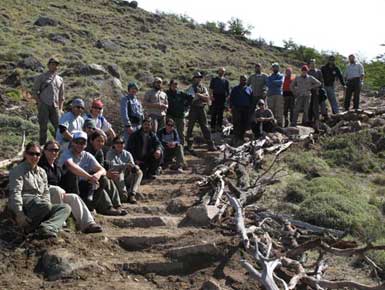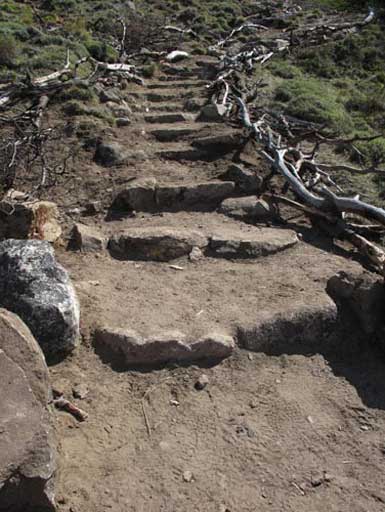Trail Restoration Project The course run between the 24th of October and 1st of November and was attended by seventeen Argentine park rangers from a number of national parks across Patagonia. The course was organized by Garibotti and directed by Ludington, with Gillespie, Kirk, Loseth and Bouknight as instructors, and Oyarzun, Martinez, Garibotti and Landucci as helpers. The participants were: Juan Alderete and Enrique Anderson from Lago Puelo NP, Joel Zambrano and Carina Rivas from Perito Moreno NP, Cristian Vellido from Monte Leon NP, Juan Montesino from Los Alerces NP, Paulina Losada and Diego Breccia from Bosques Petrificados NP, Fabricio del Castillo y Guillermina Massaccessi from Tierra del Fuego NP, Mariano Calvi and Lucas Fonzo from Nahuel Huapi NP, Federico Soria from the Delegacion Regional Patagonia, Carlos Benitez and Marco Taraborelli from the southern section of Los Glaciares NP plus Marco Cravea and Jimena Martinez Sanchez from the northern section of Los Glaciares NP. Due to lack of funding in their respective parks, many of the participants were unable to receive any kind of per-diem and had to pay their way out of their own pockets, including basic expenses such as gas. It was impressive to see such a level of commitment on their part. The parks themselves made a big effort as well, having to make due for over a week with several employees less. The nine-day course included more than 76 hours of field work. The focus was a number of techniques to help mitigate and stop erosion on heavily damaged trails. This included building drains, water bars, causeways, wood steps, rock steps, etc. Only materials available in the area were used (logs and rocks), and special importance was given to the longevity of the “structures” and sustainability of the trail. Since the parks where the participants work vary greatly in their ecosystems and geology, much emphasis was given in trying to address how different problems could be solved in each place. Also several discussions were focused on the realities of each park, availability of resources, labor and materials. One of the main conclusions was to focus primarily on drainage, which is a mandatory first step towards making a trail sustainable and requires no materials and relatively little labor. The course was divided in several themes, drainage, rock work, log work and causeways. After an initial four hour theory class on the first day the reminder of the time was spent outside doing hands on practices and actual work. Thanks to this fact much work was done in the trail surrounding El Chalten, including countless drains and many new structures. In spite of some initially difficulties due to the language barrier the course was a resounding success and likely similar experiences will be repeated in the future. The course required a large amount of time and energy from everyone involved and clearly put a dent on the work that was accomplished after it was finished. That said, it is obvious that the impact of the nine-day course will be far more important than if the project’s volunteers had spent those nine days working on the trails. This experience was so positive that it might force a rethinking of the remaining two years of the project. Left: Nick and Enrique. Right: course participants and instructors. In the days following the course, Bouknight, Gillespie, Kirk, Landucci, Loseth, Ludington and Martinez, traveled to Parque Nacional Monte Leon, a fairly new national park donate a few years ago by Conservacion Patagonica, where they spent three days helping with suggestions as to how to address some of the park’s severe erosion problems. In the 2,000 man/hours of work the following “structures” were built to prevent further erosion and ensure trail sustainability: A lot was learned from how the work done in 2008 faired over the Fall, Winter and early Spring. In the “Laguna de los Tres” trail the speed of erosion is much worse than previously thought, with two inches of soil loss in a single year in some areas. This has forced us to re-anchor some of the structures built in 2008 and also more generally has reinforced the need for hugely oversized anchors for any structures. Ultimately, after this project finishes, the work on the Laguna de los Tres trail will have to be maintained yearly to ensure it’s preservation. This trail is simply too steep and exposed to envision maintenance free structures. That said, all the structures built in 2008 held up very well, with only a handful of steps –from around 300- needing repair. In all the sections where work was done it is clearly visible that people have found the “improved” trail inviting, choosing not to short cut or step around the structures. While the objective of this project is to repair trails around the Fitz Roy and Cerro Torre massif, it has become apparent that the final impact of the project will be less pointed but much broader than that. With the time and resources at hand we might not be able to complete the work required to turn the entire Laguna de los Tres trails into a “sustainable trail”, but our work, including the trail course, is inspiring some land managers to follow a much more deliberate approach toward trail building and maintenance. That said, trail work is by no means a new concept in this area. A lot of work was done between 1997 and 2005, when now retired park rangers Adrian Falcone and Susana Queiro were in charge. Their slew of trail projects focused mostly on reroutes to solve the design problems of the existing trails, these included four long reroutes in the Rio Blanco trail, some more than a kilometer long (one 20 minutes from the trail’s start, two before and after Laguna Capri, one around Laguna Capri and one before the Poincenot camp around an ugly marsh). In the Torre trail a long reroute was done around a burnt forest area and in the Pliegue Tumbado trail the upper portion was completely redesigned. This reroutes have all held up very well. It should be explained that the majority of the trails in the area are historic trails, which were not specifically designed for foot or horse travel but originated spontaneously as a result of cattle grazing initially and later as a result of climbing expeditions. In general they take the shortest line between two points rather than taking a sustainable line at a sustainable grade. During Falcone and Queiro’s tenure some energy was also focused on building erosion prevention structures, of which two projects stand out, a long cause way over a marsh before the Poincenot camp that is still working well and close to 100 steps on the lower third of the Laguna de los Tres trail, half of which are unfortunately eroding away. Some of the knowledge that the US members of our trail crew have been able to contribute is the techniques required to ensure the longevity of the structures built. This is not a minor detail when time and resources are limited. It is always preferable to build fewer structures that last a long time than to build more that last only a couple of years. One of the items that had been missing from the local knowledge was the importance of drainage. When in March of 2008 Brian Bergsma -Trail Supervisor of Grand Teton National Park- and I carried out our first evaluation of the area we saw only one drain in the entire area. Water, together with horses –which were banned in 2007 when Carlos Duprez was in charge- have been the main culprits for the heavy erosion that these trails have seen. With horses gone building drainage is the next step. An eroding agent that is specific to this area is the wind, which blows at varying strong speeds most of the year. It is difficult to understand what its real effect is, but there are many examples of gullies up to three feet deep in places where water erosion could not have possibly taken place. Unfortunately there is no apparent simple solution to this problem, other than relocation the trails as much as possible within tree-line. Another aspect in which this AAC project might be helping is in setting a precedent for a proactive approach to conservation on the part of a user group, in this case climbers. Because parks in Argentina are so short of labor and resources it seems necessary that users, both amateurs and professionals (guides and guiding companies for example) take responsibility for their own impact and help land managers with the preservation of the places they love and care about. This concept might also apply to the US, where certain land managers such as the National Forest service are very short of resources and are unable to address the problems they have in the areas they manage (the condition of the trails in the Wind Rivers can be one example). Revegetation. Revegetation work will continue in March and April 2010. Other. Thanks. |
Related articles
Project description
Work reportsReport 2008Report 2009
Revegetation reports
Revegetation 2/09 (pdf)
Revegetation 4/09 (pdf)Revegetation 12/2009 (pdf) Acces/Acceso Montaña de todosMontañas prohibidas |
SITEMAP
If you find this web page useful, please consider making a donation
PATAclimb |
Climbing is dangerous, take responsibility, climb at your own risk. © 2010 Rolando Garibotti. All rights reserved.









